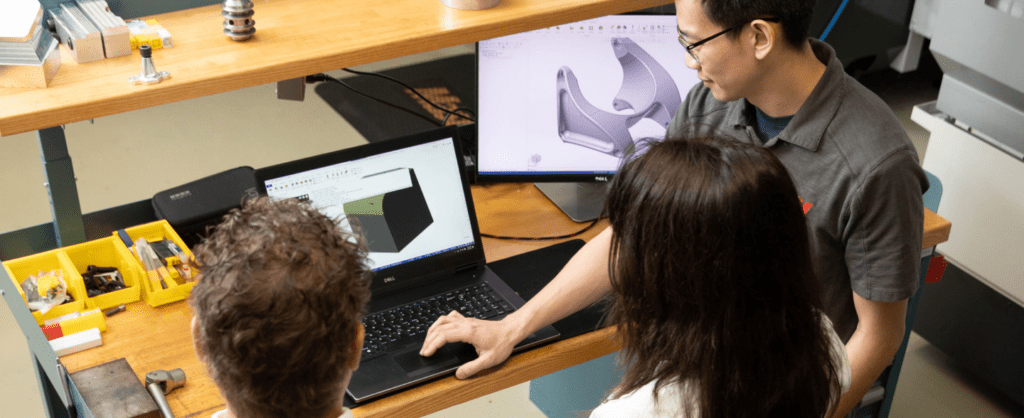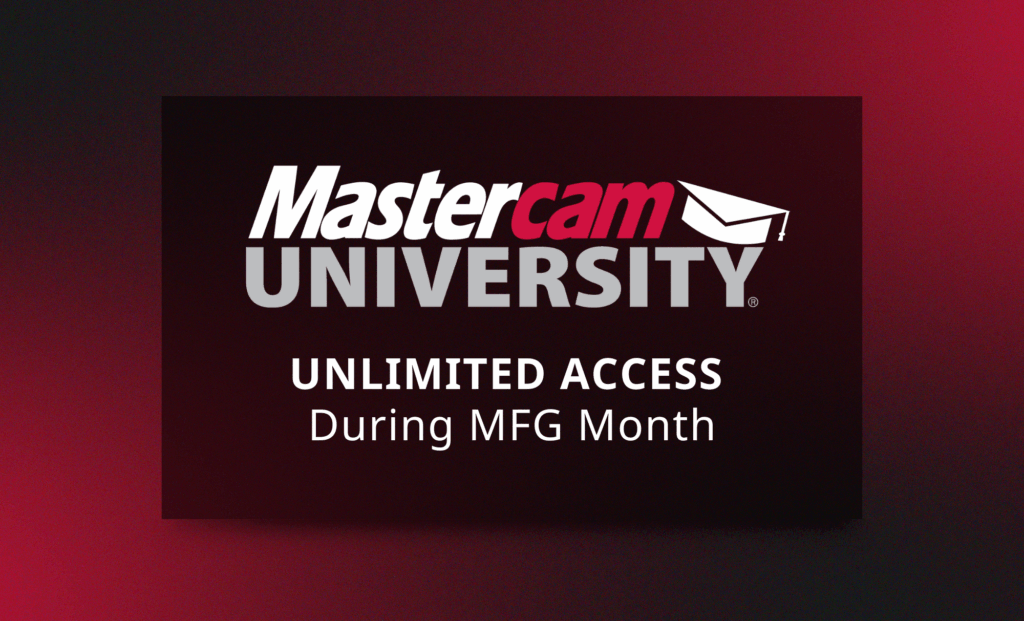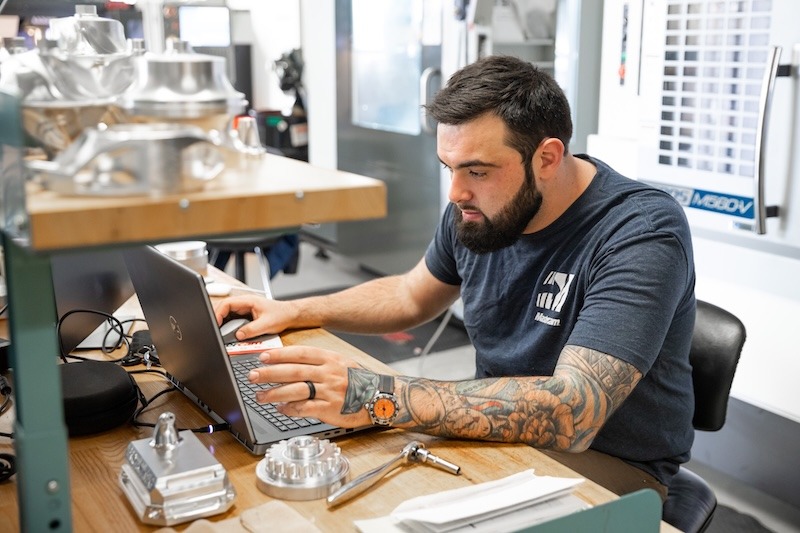
I never expected a simple STEM grant to completely redirect my career path toward manufacturing and CNC programming. While teaching at Presidio Public Schools in Texas, we received funding that introduced advanced CNC machines and STEM technology into our classroom. Suddenly, I became the lead instructor for a new course, “Engineering Design and Presentation,” even though I was new to operating CNC machines and CAD/CAM software.
That moment of uncertainty sparked an eight-year journey from teaching to becoming a CNC programmer and engineer in the manufacturing industry. Today, I work as a Technical Content Developer and Trainer at Mastercam, a leader in CAD/CAM software. Along the way, I discovered a crucial industry need: bridging the gap between STEM education and real-world manufacturing applications.
The Skills Gap Is Real—And It Is an Opportunity
During my manufacturing career, I witnessed firsthand the workforce challenges highlighted by industry statistics. The numbers are staggering:
- 2.1 million manufacturing jobs could go unfilled by 2030 if we don’t act now
- 3.8 million new jobs will be needed over the next decade
- 25% of the manufacturing workforce is aged 55 or older—I worked alongside many of these experienced professionals who are nearing retirement
- 80% of manufacturers report difficulty finding qualified workers
But here’s what those statistics don’t tell you: each unfilled manufacturing job represents an opportunity for anyone eager to learn STEM and manufacturing skills. Over my eight years in the industry, I saw companies compete for skilled professionals, offering attractive salaries, benefits, and career growth to those who had expertise in CAD/CAM software, CNC machining, and digital manufacturing.
What I Learned About What Employers Really Want
My unique perspective—having been both an educator and a manufacturing professional—taught me that technical skills are just the starting point. When I was hiring for my team or evaluating potential programmers, I looked for much more than just the ability to run Mastercam.
The Foundation (What Gets You in the Door)
Yes, you need to know CAD/CAM software. You need to understand measurement tools, quality standards, and safety protocols. But honestly? I could teach those skills to someone motivated to learn.
Key Skills for Manufacturing Careers: Differentiators That Get You Promoted
What I couldn’t easily teach were the adaptive skills that separate good operators from great engineers:
- Problem-solving mentality: When a tool breaks at 2 AM during a critical run, can you figure out a solution?
- Learning agility: When we invested in new 5-axis machines, who stepped up to learn them?
- Communication skills: Can you explain to the day shift what happened during your night run?
- Systems thinking: Do you understand how your setup affects downstream operations?
- Business acumen: Can you balance quality with productivity and cost?
My teaching background actually became my secret weapon in manufacturing. I could explain complex processes to new hires, document procedures clearly, and bridge communication gaps between engineering and the shop floor. These “soft skills” accelerated my career progression from operator to programmer to engineer faster than my purely technical colleagues.
Why I Joined Mastercam’s Education Mission to Advance STEM and Manufacturing
After eight successful years in manufacturing, I had an idea. With my web development background, I wanted to create online Mastercam training resources. When I reached out to Mastercam about a potential partnership, they offered me something even better—the chance to help shape their entire education strategy.
Now, I get to combine everything I’ve learned to help others navigate this path more smoothly than I did. Here’s what we’re providing to educators and students:
The Complete Mastercam Educational Package for STEM and Manufacturing
We give schools access to the full Mastercam suite—Mill, Lathe, Multiaxis, Mill-Turn, Wire, Router, and Design. Starting in 2026, we’re even adding CIMCO Probing. This isn’t some watered-down educational version; it’s the same comprehensive platform I used in industry.
Learning Beyond the Classroom
I remember struggling to practice at home when I was first learning. That’s why we created the free Learning Edition. Students can design and program at home, even if they can’t generate actual G-code. It’s perfect for homework and skill-building outside lab hours.
Structured Online Learning Paths
Through Mastercam University, I help develop courses that take learners from absolute beginners to advanced programmers. We’ve created:
- Comprehensive series for each major discipline
- Quick “Show Me” videos for specific tasks (because sometimes you just need to know how to create a specific toolpath)
- Detailed “Teach Me” articles for deeper understanding
- Special access programs, including free unlimited access during Manufacturing Month
Industry-Recognized Manufacturing and CNC Programming Credentials
One thing I learned in manufacturing: certifications matter. Our third-party validated certifications in 2D Mill, 3D Mill, Lathe, Core, and Multiaxis give job seekers tangible proof of their skills. I’ve seen firsthand how these credentials can be the differentiator in a stack of resumes.
Building Community Through MEA
The Mastercam Educators Alliance now connects over 800 educators. I wish I’d had this resource when I was starting out—a place to share challenges, exchange ideas, and get support from others on the same journey.
My Advice for Educators Starting This Journey
Based on my experience both teaching and implementing these skills in industry, here’s what works:
Start Simple, Build Confidence
Begin with basic 2D operations. Let students experience success before introducing complexity. I learned this the hard way—throwing students into complex 3D programming too early just creates frustration.
Simulation Is Your Friend
Use Mastercam’s simulation extensively. In industry, crashes are expensive. In education, they’re learning opportunities—but only if you catch them in simulation first.
Connect with Local Manufacturers
The partnerships I formed with local companies as a teacher became invaluable when I transitioned to industry. These relationships provide real projects, potential mentors, and often lead directly to job placements for students.
Teach the “Why,” Not Just the “How”
Anyone can memorize which buttons to push. I always pushed my students to understand why we choose specific tools, speeds, and strategies. This deeper understanding is what employers really value.
The Big Picture: Why STEM, CNC Programming, and Manufacturing Education Matter
My journey from education to manufacturing and back to education (in a new form) taught me something important: we’re not just teaching technical skills. We’re opening doors to careers that offer stability, growth, and the satisfaction of creating tangible products.
When I was teaching in that small Texas town, many of my students had limited career options. Introducing them to CAD/CAM and CNC machining literally changed their life trajectories. Some went on to technical schools, others directly into manufacturing careers. Several now out-earn their teachers (including what I made as an educator).
Your Turn: Where Will Your Journey Lead?
If you’re an educator considering adding manufacturing to your curriculum, I want you to know that you don’t need to be an expert to start. I wasn’t. The resources are available, the support exists through communities like MEA, and the impact you can have on students’ lives is immeasurable.
If you’re a student wondering whether manufacturing is right for you, let me be clear: this industry needs problem-solvers, innovators, and people who can bridge the gap between digital design and physical production. The opportunities are real, the careers are rewarding, and the skills you learn are transferable across industries.
If you’re already in industry, consider how you can support education in your area. Share your expertise, offer internships, or simply tell your story. You might inspire the next generation of manufacturing professionals.
Continuing the Mission: Bridging the STEM Education and Manufacturing Skills Gap
Today, as part of the Mastercam team, I get to help thousands of educators and students navigate the path from classroom to career. Every success story—every student who lands their first CNC job, every educator who successfully implements a new program—reminds me why this work matters.
The manufacturing skills gap isn’t just a challenge; it’s an opportunity for those willing to seize it. With the right tools, training, and support, anyone can make the transition from classroom to career in manufacturing. As we say at Mastercam: Teach. Make. Inspire. For me, it’s not just a tagline—it’s my story, and it could be yours too.
Ready to start your own journey? Download the free Mastercam Learning Edition, explore our resources at the Learning Hub, or join the Mastercam Educators Alliance. If I could make this transition from a small-town teacher with no CNC experience, so can you.



